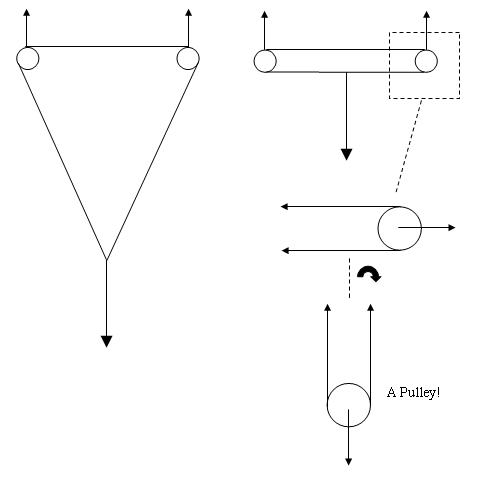
 |
|
Forums:
Climbing Disciplines:
Trad Climbing:
Re: [styndall] Anchor Analysis: is this adequate?:
Edit Log
|
|

redlude97
Aug 10, 2010, 8:18 PM
Views: 7540
Registered: Aug 27, 2008
Posts: 990
|
styndall wrote: redlude97 wrote: jt512 wrote: redlude97 wrote: milesenoell wrote: redlude97 wrote: jt512 wrote: redlude97 wrote: The carabiner works in the same way just with more friction. To say one is a pulley and the other is not when rigged in the same way IMO doesn't make any sense. They still give you the same mechanical advantage(minus the loss to friction). The carabiner is indeed acting as a pulley with friction, but a single carabiner or pulley attached to a fixed position provides no mechanical advantage. Jay The force felt by the fixed pulley/anchor is twice the force applied. That is what I meant by mechanical advantage. If you didn't fix the anchor/pulley and instead hung your object from the biner/pulley, it would move half the distance and require half the force compared to pulling it directly up. Uh, no. Whether I pull rope from the top, right at the anchor or from the bottom as the belayer makes no difference. 1 foot for me is 1 foot for the climber. The only way it would change is if I were to pull up on the anchor itself, and since that has never been a situation we were looking at, I consider the point to be moot. Maybe I wasn't clear in what I was explaining. Yes the distance you pull on either end of the rope is the same. In that sense it is a redirect. The way a single pulley can have mechanical advantage is to hang the object to be moved from the pulley itself. In that case the force is 1/2 and the distance moved is 1/2. Like this: [image]http://upload.wikimedia.org/wikipedia/commons/thumb/b/bb/Pulley1.svg/399px-Pulley1.svg.png[/image] The reason this applies to the ADT is the doubling of the force felt by the anchor/biner/pulley(minus friction and angles). No, that doesn't apply to an American Triangle (AT) at all. A pulley attached to the load affords a mechanical of 2. In an AT the "pulleys" aren't attached to the load but to fixed positions, so there is no mechanical advantage. Rather, for any angle at the bottom of the triangle, there is a greater force on the bolts due to the horizontal arm of the triangle, relative to a V-shaped anchor with same angle. Jay Yes no mechanical advantage. I shouldn't have ever used that term. Force mutliplication, even on a fixed point at a redirect is by definition a pulley effect though. Argh. Not all force multiplication falls under 'pulley effect.' I can make a lever with a bit of bar stock. Does my lever use the pulley effect?

(This post was edited by redlude97 on Aug 10, 2010, 8:21 PM)
|
|
Attachments:
|
 ADT Pulley.jpg
(13.8 KB)
ADT Pulley.jpg
(13.8 KB)
|
|
|
Edit Log:
|
|
Post edited by redlude97
() on Aug 10, 2010, 8:20 PM
|
|
Post edited by redlude97
() on Aug 10, 2010, 8:21 PM
|
|
Post edited by redlude97
() on Aug 10, 2010, 8:21 PM
|
|
|
 |
|

|